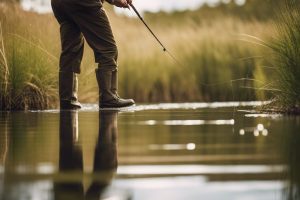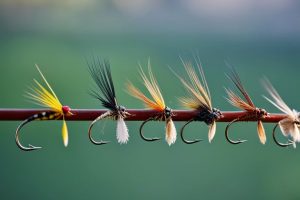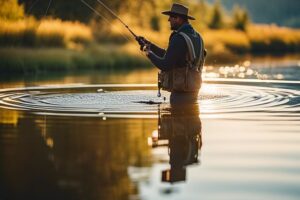You need the right fly line configuration to enhance your success with dry flies. A well-chosen line can make the difference between a good day and a great one on the water. This guide will help you understand the types of lines, their characteristics, and how to match them with your rod and style. Mastering your line setup will allow your dry flies to present naturally and catch the wary eyes of rising trout. Let’s probe the necessarys of fly line configuration for dry fly fishing.
Choosing the Right Fly Line
While selecting the ideal fly line for dry fly fishing, you must consider how different weights and densities impact your performance on the water. This will determine not only how effectively you can cast but also how your flies present on the surface. A properly matched line will enhance your ability to deliver precise casts and maintain the right drift, crucial elements when targeting rising fish with dry flies.
Weight and Density
The weight of your fly line is critical. Generally, for dry fly fishing, you will want a line that matches your rod’s weight rating. This ensures optimal casting accuracy and distance. A line that is too heavy may cause unwanted sag and will pull your fly under the surface, while one that is too light can lead to poor casting and inadequate turnover. Most anglers find that a floating line suits most dry fly scenarios, as it allows for better line control and presentation.
The density of your line also plays a notable role. Floating lines are standard for dry flies, as they keep your fly at the desired level on the water. However, if you fish in fast-moving water where you need to get your fly down a bit, you might consider a line with a slightly heavier density that still supports a floating profile. This gives you the versatility to adapt to varying conditions while ensuring your fly remains suspended where you need it.
Taper and Profile
For successful dry fly fishing, understanding the taper and profile of your line can elevate your game. The taper refers to the thickness of the line and how it changes along its length, which impacts how energy is transferred during your cast. A line with a front-loaded taper allows for easier and more precise short-distance casts, vital when you’re targeting local rises that demand stealth. Conversely, a longer taper aids in delivering smoother casts over greater distances, ensuring that your fly lands softly on the water’s surface.
Profile matters as well. The shape of your line influences its ability to float and its air resistance during the cast. You want a line with a profile designed for precision and control, perfecting the delivery of your dry flies. Quality tapering and a well-optimized profile together enhance your overall performance and ensure that your fishing experience remains enjoyable and productive.
Leader Configuration
Some might overlook the significance of leader configuration in dry fly fishing, but it is a crucial component that can elevate your success on the water. The right leader helps deliver your fly softly to the surface, ensuring a natural presentation that entices rising fish. Leaders vary by length and material, and understanding these differences can impact your effectiveness in various fishing conditions.
Leader Length and Material
Configuration of your leader should be tailored to your fishing style and the specific conditions you’re facing. A general rule is to use a leader that is about 9 to 12 feet long for dry flies. This longer length allows for a finer presentation and helps prevent spooking fish. As far as materials, monofilament or fluorocarbon are preferred, with fluorocarbon having the edge in terms of invisibility underwater while offering a bit more sensitivity. Choose a leader that complements the size of your fly and the expected behavior of the fish.
Knots and Connections
Length isn’t the only consideration when setting up your leader. Choosing the right knots and making solid connections is vital for performance. Use a loop-to-loop connection to attach your leader to the fly line, which allows for quick changes and keeps the leader intact. For tying on flies, the improved clinch knot is widely recommended due to its strength and reliability. Each connection should be seamless, ensuring that energy transfers effectively when you cast.
Understanding how your knots affect your leader’s performance can make a difference when targeting selective fish. A poorly tied knot can lead to lost opportunities and frustration on the water. Take time to practice your knot-tying skills and ensure that each connection is properly tightened and trimmed. By paying attention to the small details of leader configuration, you enhance not only your chances of a successful catch but also the overall experience of fly fishing.
Tippet Selection
There’s no escaping the importance of tippet selection when it comes to dry fly fishing. This often-overlooked piece of your setup can significantly impact your ability to present flies correctly and catch fish. Choosing the right tippet ensures that your flies float beautifully on the surface while providing enough strength to land your catch. It’s not just about catching fish; it’s about the finesse in your technique and the connection you build with the water.
Diameter and Strength
To maximize your chances of landing that elusive trout, you need to consider the diameter and strength of your tippet. A thinner diameter allows for an effective float, helping your dry flies to skim effortlessly across the surface. Generally, tippets range between 5X to 7X for most dry fly applications, where 5X is about 0.006 inches in diameter and capable of handling larger fish. However, if you’re targeting spooky fish in clear water, switching to a 6X or even 7X tippet can make all the difference in presentation.
Alongside diameter, the strength of your tippet should not be compromised. While you want your line to be fine enough to remain undetected, it must also have the adequate tensile strength to withstand the quick runs of a fish. Assess the average size of the fish you’ll be targeting and choose a tippet that balances delicacy and durability. The last thing you want is to lose a hard-earned catch due to a weak tippet.
Tippet Ring vs. Blood Knot
An important decision in your tippet setup lies between using a tippet ring or tying a blood knot. A tippet ring allows you to connect your leader to the tippet without creating extra bulk and maintains a flexible connection that aids in better fly presentation. This is particularly valuable when you need to change tippet sizes frequently or when targeting different species, making your setup more adaptable and efficient.
The choice between a tippet ring and a blood knot really boils down to personal preference and fishing conditions. A blood knot creates a tighter connection with lower visibility, which can be beneficial in challenging fishing environments. However, this knot can be cumbersome to tie, especially in cold weather or when under pressure. The tippet ring offers efficiency and ease, allowing you to swap tippets swiftly while maintaining a clean line setup. Ultimately, assess your fishing style and target species to decide which method suits you best.
Dry Fly Presentation
For successful dry fly fishing, how you present your fly is critical. You want to mimic the natural movements of insects on the water’s surface. When your fly is presented delicately, it mimics the effortless landing of a natural insect, enticing trout to strike. It’s vital to consider your line and leader setup carefully, and you can find useful insights on this topic in the Dry Fly Line/Leader Setup : r/Tenkara thread. An optimal balance between your line weight and fly size enhances your chances of success.
Casting Techniques for Delicate Presentation
Delicate presentation starts with your casting technique. Use a light touch when delivering your fly. Overly aggressive casts can slap the fly onto the water, creating unwanted disturbances. Instead, focus on a smooth, gentle motion that allows the fly to land softly. Practice your backcasting in open spaces so that you can lay your line out with precision when it’s time to cast over the fish.
As you become more comfortable, experiment with different angles and distances. The ability to cast accurately will determine how well your fly is presented. Aim for a 30-degree angle to deploy your fly upstream or across the current. This angle helps your fly drift naturally with the flow of the water, increasing the chances of enticing a strike.
Mending and Line Control
To maintain a natural drift, mending is as crucial as your casting technique. When you cast, your line may drag due to currents. Mending involves repositioning your line to ensure your fly floats freely with the water. This technique helps to eliminate slack and keeps your fly in the fish’s feeding zone longer.
Presentation is not just about casting; it’s also about controlling your line on the water. Consider the underlying currents and adjust your mend accordingly. A well-timed mend allows you to guide the fly directionally while maintaining tension. When your fly behaves as naturally as possible, you increase your odds of a successful catch. Aim for subtlety and finesse in every aspect of your technique for optimal dry fly presentations.
Line Management
Your approach to line management can greatly influence your success with dry flies. Proper storage and organization of your lines will ensure they remain in top condition, ready for action. Taking a few simple steps can save you time and frustration on the water. Treat your fly line with the respect it deserves, and it will reward you with better casts and fewer headaches.
Line Storage and Organization
One key aspect of line management is how you store your lines when they are not in use. It is best to avoid leaving your fly lines in direct sunlight for extended periods, as UV rays can degrade the material. Instead, invest in a good line spool and store your lines in a cool, dry place. You can also use line organizers or bags to keep your lines separated and tangle-free, preventing them from getting twisted or damaged when not in use.
Another important tip is to label your spools, especially if you have multiple lines for different conditions. Clearly marking the line type, weight, and leader length on each spool can save you valuable time when preparing for your next dry fly fishing trip. With a well-organized setup, you’ll know exactly what you need, and you can hit the water with confidence.
Preventing Tangles and Kinks
Tangles can be the bane of any angler’s experience, especially when you’re trying to enjoy a quiet day on the water. To prevent these frustrating knots, there are a few necessary practices to adopt. Always reel in your line carefully and avoid forcing it onto the spool. When you are done fishing for the day, treat your line by cleaning and drying it before storing. This maintenance helps in preventing memory coils and keeps the line smooth for your next outing.
To further safeguard against tangles, consider using line management tools during your fishing sessions. Line strippers and guides can help keep your line in order, particularly when you’re shifting between different fly patterns or depths. By establishing a consistent routine of handling and caring for your fly line, you can enjoy more productive and less frustrating days on the water.
Adapting to Water Conditions
Not every day on the water is calm. Conditions change, and so must your approach. Adapting your line setup is crucial for effective dry fly fishing. When you encounter wind or fast-moving water, being aware of how these elements interact with your line can make a marked difference in your success.
Fishing in Windy Conditions
Any seasoned angler knows that casting in windy conditions can turn a simple outing into a challenging endeavor. The wind can carry your fly off course, leading to missed strikes and frustrated attempts. In these situations, you should consider using a heavier fly line that can cut through the breeze more effectively. A weight-forward line, for example, helps you maintain control, ensuring that your presentation remains on target despite the gusts.
Additionally, you might want to shorten your casts and focus on accuracy rather than distance. A solid casting technique, combined with a proper line length and weight, enables you to drop your fly with precision. Keep in mind, it’s not just about getting your fly on the water; it’s about getting it where the fish are, even when the wind tries to play tricks on you.
Fishing in Fast-Moving Water
One of the greatest challenges you face when fishing in fast-moving water is managing your fly’s drift. The current can drag your line and leader quickly, often leading to unnatural presentations. To combat this, consider using a longer leader, which can help to slow down your fly’s descent. This setup allows for a more natural and imitative drift, crucial for enticing fish in turbulent waters.
Fast-moving water poses unique challenges. With the force of the current, your fly must be able to sit convincingly in the water column. A well-placed dry fly needs to be buoyant and ideally weighted to help it land softly yet effectively. This necessitates the use of a floating fly line that provides the buoyancy required for a lifelike presentation. Pairing this with the appropriate leader setup can be the key to successfully navigating the currents and connecting with the fish below.
Conclusion
With these considerations, you can now approach dry fly fishing with a clearer understanding of how line configuration impacts your success. Choosing the right weight forward taper, combined with a floating line, allows your fly to drift naturally on the surface. Recall, each component of your setup plays a role—from the leader length to the tippet size—ensuring that your dry fly lands gently and maintains a lifelike presentation. Stay mindful of the conditions and adjust your gear as needed to optimize your chance for that perfect catch.
Your time on the water should be about simplicity and connection. With a well-thought-out fly line configuration, you’re not just casting; you’re inviting the fish to participate in the dance. Pay attention to your surroundings and trust your instincts. This is where the poetry of dry fly fishing unfolds, and with practice, you’ll find the rhythm that makes each outing rewarding. Achieving excellence in your setup will yield not just fish, but moments of clarity in nature, making every trip worthwhile.
FAQ
Q: What is the best type of fly line for dry fly fishing?
A: The best type of fly line for dry fly fishing is a weight-forward floating line. This type of line allows for easy and accurate casting of light dry flies, providing a smooth turnover and a delicate presentation on the water’s surface. The floating capability ensures that the fly stays above water, making it easier to detect strikes. Additionally, a line with a taper designed for dry flies can enhance control and precision when casting.
Q: How does line weight affect dry fly fishing?
A: Line weight plays a crucial role in dry fly fishing. The weight of the line should ideally match the weight of the rod being used. A line that is too heavy can overpower small dry flies, causing them to land harshly and spook fish, while a line that is too light may struggle to deliver the fly accurately. Most anglers use a line that is one weight higher than the rod rating when fishing in windy conditions, as this can help achieve better casting distance and accuracy without sacrificing presentation.
Q: What are the benefits of using a leader and tippet setup with dry flies?
A: A leader and tippet setup is vital for dry fly fishing because it allows for a more natural presentation of the fly. The leader, usually tapered, helps to transfer energy from the fly line to the fly, ensuring a smooth turnover and preventing line drag in the water. The tippet, which is finer and less visible, connects the leader to the dry fly and minimizes the chances of spooking fish. Using the right length and diameter of leader and tippet helps to maintain stealth and enhance the overall effectiveness of your dry fly technique.


